

 The South African
The South African
Christopher Charles Teesdale was the first South African born recipient of the Victoria Cross, and his unique award was one of the very last gazetted to the army for the Crimean campaign of 1854-56.
Firstly, let me tell you how the wrong man was credited as being the first S.A. born V.C. recipient.
Ian Uys in his book "For Valour - the History of Southern Africa's Victoria Cross Heroes" published in 1973, incorrectly gives credit to Joseph Petrus Hendrick Crowe born in Uitenhage on 12th January 1826 as being the first South African born recipient of the Victoria Cross.
He was the second son and sixth child of a retired lieutenant of the 60th Foot, and his Cape Dutch wife Clasina Vermaak.
Young Joseph desired to follow in his father's footsteps, and was appointed an ensign in the 78th Foot (later the Seaforth Highlanders) in 1846 and joined his regiment in India. He was awarded the V.C. for an act of gallantry performed on 12th August 1857 during the Indian Mutiny.
Many other writers, before and since that time, have made the same mistake of naming Crowe as the first S.A. born recipient of the Victoria Cross. For example, an article which appeared in the English magazine Medal News in February 2002 entitled "Joseph Crowe, The first South African V.C.."
In September 2003 I gave a talk to the Durban branch entitled "The first, and the last surviving, South African born recipients of the Victoria Cross." To my knowledge, no one else had at that time established that there was an earlier contender to Crowe.
Christopher Charles Teesdale was born on 1st June 1833 in Grahamstown and was baptized on 26th June that year at St George's church, which was later combined with St Michael's church to become the Cathedral of St Michael and St George in Grahamstown, and which is still today reputed to have the tallest spire in South Africa.
His father Henry George Teesdale was a young lieutenant in the 8th company of the 8th battalion Royal Artillery. This unit served at the Cape from June 1830 until December 1841. According to the South African Almanac and directory for the years 1831 through to 1834, the name of this officer appears in the list of six Royal Artillery officers serving in the Cape. His name does not appear from 1835 onwards. He ended his career in 1892 as a lieutenant-general.
So, young baby Teesdale was only a resident of the Cape for less than two years whilst his father was on Foreign Service in this part of the world. Some would say an accident of place of birth because of his father's occupation.
Joseph Crowe however was the child of a former British officer of the 60th foot who had already retired to the Cape when Joseph was born in Uitenhage in 1827. The couple had married at the Cape, and a number of their older children were born at the Cape, but some children were also born in Britain.
It is accepted that some readers would challenge my claim for Teesdale.
In 1848 aged 15 young Christopher Teesdale was accepted as a gentleman cadet in the Royal Artillery, and was commissioned as a second lieutenant on Waterloo Day, 18th June 1851. He was stationed at Corfu from February 1852 to May 1853 prior to the Crimean war.
In a military career spanning 44 years,the uniqueness of his V.C. is that Teesdale was to see active service in only one war, and that was not to be with the British army, but with the Turkish army. Thus we have an interesting story indeed.
There are only seventeen instances of men wearing a Victoria Cross without an accompanying British campaign medal for the V.C. action period.
For the first Boer war of 1881 there were six Victoria Crosses awarded, but no campaign medal was approved. Britain did not issue a campaign medal for wars which were lost.
It is not known whether there is any other case of a V.C. being awarded to a recipient who was at the time of the deed, serving on secondment to a foreign army.
As the British and French forces made their way to the Crimea, intending to destroy the Russian Black Sea fleet and the Sebastopol port, in order to prevent a Russian naval advance on Constantinople, the land route through the Caucasus and Asia Minor was protected by a large Turkish standing army in the east of thecountry guarding against a Russian invasion from Tiflis.
Earlier in 1854 the Russians had moved 35,000 troops into the area, hoping to open up a 'second front' against a weak and disorganized army, thus having a largely unopposed march west.
On 3rd August a Turkish force of 8,000 was routed by 11,000 Russians at Bagazid; 1,800 Turks were killed or wounded.
Three days later, at the battle of Kurukdere, the result was even more emphatic, with the Turkish force this time numbering over 35,000, again heavily defeated; only the caution showed by the Russian commander saved the Turkish army from being completely annihilated.
The disorganized remnants of Ottoman power in Asiatic Turkey fell back on the town of Kars.
By the end of June some 35,000 to 40,000 Russian troops had arrived in the area and set up camp four miles from Kars, under the command of General Mouravieff.
Kars is situated at the far eastern most point of Turkey, over 1,000 miles from Constantinople, at a height of 1,770 metresabove sea level, its climate was harsh and its land rocky.
By its location it was a key to Asia Minor - if the Russians could capture it then they could enter the Ottoman Empire and materially affect the course of the Crimean War...
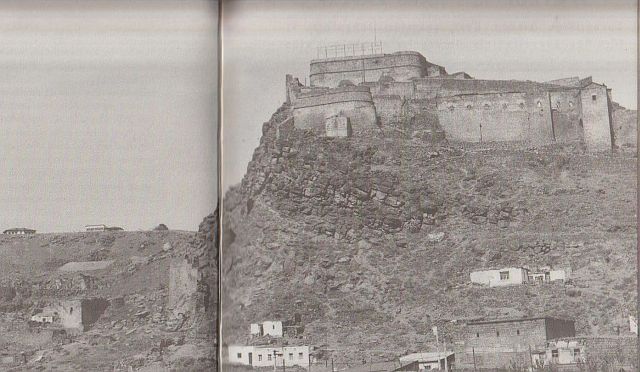
The citadel at Kars.
Kars was under the control of the Ottoman Empire for centuries. For a brief period 1878 to 1917 it was controlled by Russia, and from 1918 to 1920 was under the administration of the Democratic Republic of Armenia. The territory was ceded back to Turkey in 1920.
It was decided back in London, to send a British Commissioner with a small staff to join the Turkish force in the east, and for him "to pick up what political information he could."
This man was Colonel Williams R.A., given the temporary rank of Brigadier General. He was accompanied by Lieutenant Teesdale as his A.D.C. with the temporary rank of Major.
Williams was to maintain a liaison with the Ottoman Porte in Constantinople and Lord Raglan's H.Q. in the Crimea.
Williams, Teesdale and Dr Sandwich, the Inspector General of Hospitals in Asia Minor, arrived in Kars in September 1854, but Williams and Sandwich soon left to spend the winter traveling through Asia Minor, leaving the 21-year-old Teesdale on his own in the town, to keep an eye on the situation there.
Williams and Sandwich returned the following April, joined by three more Englishmen one of whom was Lt-Col. Henry Lake, Royal Engineers, who was to play a major role in improving the defences of Kars. Together they set about getting the town's defences and men into a state of readiness.
A series of fortifications designed and constructed to cover the heights behind Kars and a series of redoubts south of the river.
The Russian siege of Kars commenced on 18 June 1855 and lasted 5½ months until the starving garrison was forced to capitulate at the end of November.
The besieging Russian force numbered 50 000 men.
For June and July the Russians were occupied in reconnaissance and skirmishes to probe the town's defences.
On 8th August in the absence of General Mouravieff for a period, the skirmishes became more intense.
In Teesdale's own words, "the Russians were quite deceived by our silence on the day of the demonstration in that quarter as to the range of our guns, and therefore came within easy range of them before they were made painfully aware of the fact.
Just as the enemy retreated, Teesdale, who from the opposite side of the defences heard the firing, galloped up to the menaced position, ordered a large canon to be elevated, and, laying the piece himself, threw a ball of enormous magnitude into the midst of the retreating squadrons, causing havoc amongst them.
Thus Teesdale had the honour of firing, with his own hands, the last and best shot of the action.
By the end of August the effects of the siege were being felt - fewer and fewer carts from the surrounding countryside were getting into Kars, and the Russian army destroyed stores of grain in every village through which they passed.
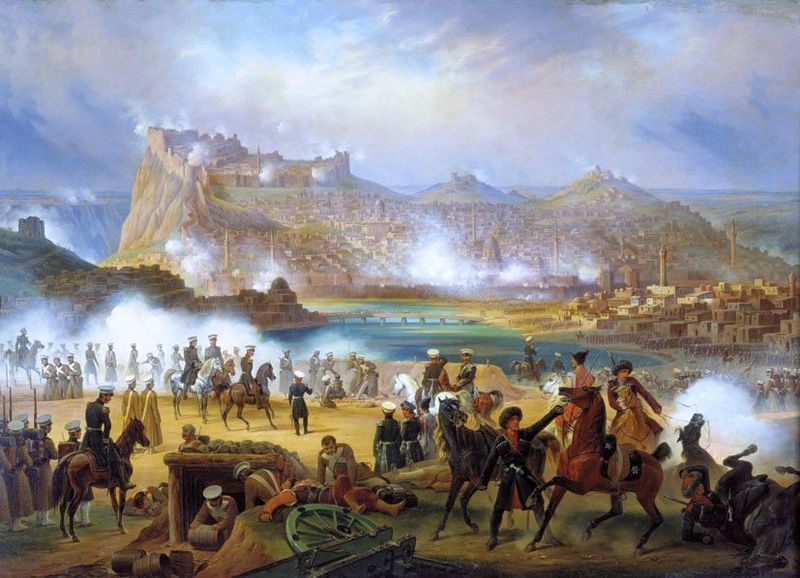
The front cover of this issue featured an oil painting entitled
Battle for Kars, by Polish artist Janvier Suchodolski in 1839.
News of the fall of Sebastopol reached Kars on 17th September. The defenders by this time were on less than half rations.
Reinforcements were desperately needed, and plans were drawn up to send a relief force.
The heaviest attack was made by forty thousand Russians on 29 September, in which their losses numbered six thousand.
A few sentences quoted from Brigadier-General Williams' dispatch dated that same day:
"General Mouravieff, with the bulk of his army, at day-dawn this morning,
attacked our entrenched position on the heights above Kars, and on the opposite side of the river.
"The battle lasted, without a moment's intermission, for nearly seven hours, when the enemy was driven off in the greatest disorder, with the loss of 2,500 dead, and nearly double that number wounded, who were, for the most part, carried off by the retreating enemy. Our losses were 700 killed and wounded."
The V.C. to Teesdale was gazetted on 25th September 1857, almost two years after his act of gallantry. The citation reads as follows:
For gallant conduct on 29th September 1855, in having, while acting as aide-de-camp to Major-General Sir William Fenwick Williams, Bart., KCB, at Kars, volunteering to take command of the force engaged in the defence of the most advanced part of the works, - the key of the position - against the attack of the Russian army; when, by throwing himself into the midst of the enemy, who had penetrated into the above redoubt, he encouraged the garrison to make an attack so vigorous as to drive out the Russians there-from, and prevent its capture; also for having during the hottest part of the action, when the enemy's fire had driven the Turkish artillerymen from their guns, rallied the later, and by his intrepid example induced them to return to their post; and further, after having led the final charge, which completed the victory of the day, for having at the greatest personal risk saved from the fury of the Turks a considerable number of the disabled among the enemy, who were lying wounded outside the works, an action witnessed and acknowledged gratefully before the Russian staff, by General Mouravieff.
Having deployed his troops once and lost, Mouravieff was in no hurry to do it again, and instead re-focused his efforts on maintaining the siege, and starving the defenders into submission.
Wood stocks had all but vanished, and the cold at nights became so bitter that numbers of men were found every morning to be frozen to death in their tents. Dr Sandwich described the conditions in the town thus: "at last the pangs of hunger became unendurable; grass was torn up wherever it appeared, that soldiers and people might feed upon the roots."
Round the lines flocks of vultures hovered, contending with the dogs of the city for the corpses scratched by the latter from their shallow graves.
The soldiers had been dying at a rate of one hundred a day of famine.
Following a council of war on 24th November, and with no prospect of being relieved, the inevitable decision to surrender was reached.
Teesdale was sent with the flag of truce and a note from General Williams to the Russian camp. At the outpost he was blind-folded by the Cossacks and led to General Mouravieff.
He was treated with great civility and allowed to return.
The following day Teesdale accompanied General Williams to the Russian headquarters.
The formal surrender took place at an old Genoese church three miles from Kars. The officers and regular troops of the garrison, around 8,000 in all, were made prisoners of war; 6,000 irregulars were allowed to go free.
General Mouravieff allowed officers of all grades to retain their swords, in consequence of the brave defence made by the garrison of Kars.
The four British officers were taken into custody at the Russian town of Tiflis.
The Russians finally had control of Kars, and with it the door to Constantinople lay ajar; but it was too late.
On the conclusion of hostilities in the Crimea and the signing of the treaty of peace on 30th March 1856, the four British officers were released. Williams and Teesdale were granted an audience with the Tsar in St. Petersburg.
Teesdale had been wounded and was held by the Russians from November 1855 to January 1856. He arrived back in England on 11th June 1856, reverting to the substantive rank of Lieutenant, R.A..
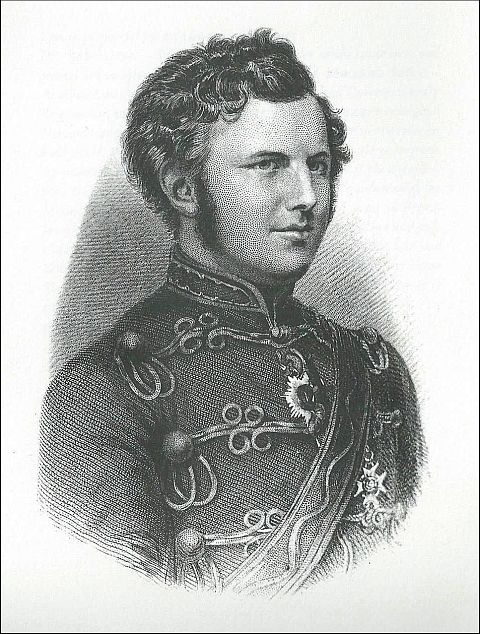
Teesdale wearing his early awards
Immediately after the battle his excellency the Mushir, by virtue of the authority with which he had been invested by the Sultan, conferred on Captain Teesdale the third class of the Imperial Order of the Medjidie, and promoted him to the rank of Lieutenant Colonel in the Turkish army.
He was also given the Turkish Imtiyaz medal with "Kars" riband bar, and the Turkish Defence of Kars Medal 1854. This is possibly a unique pairing of a foreign campaign medal with a Victoria Cross.
In 1856 Teesdale was admitted a Companion of the Order of the Bath, and by the French government he was given the Legion of Honour 4th class. All these honours were earned by Teesdale at the young age of 22.
The V.C. was presented to him by Queen Victoria in the quadrangle of Windsor Castle on 21 November 1857.
There were 111 Victoria Crosses earned for the Crimea, and Teesdale's was last to the land forces; the very last being two to navy personnel.
General Williams for his part was created a Knight Commander of the Order of the Bath and raised to a baronetcy with the title Sir William Fenwick Williams of Kars. The other two British officers and Dr Sandwich were created Companions of the Order of the Bath.
Christopher had an elder brother Harry also born in Grahamstown, who was the only Royal Engineer officer wounded at the battle of Alma on 20th September 1854, and who died in hospital at Scutari on 22nd October 1854.
Teesdale was promoted Captain and brevet Major in January 1858, and in November that year was appointed equerry to the Prince of Wales. Promoted brevet Lieutenant-Colonel in December 1868, and to the ultimate rank of Major-General in April 1887.
He was appointed an aide-de-camp to the Queen from 1st October 1877, and created a Knight Commander of the order of St. Michael and St. George in 1887 in celebration of Queen Victoria's Golden Jubilee. .
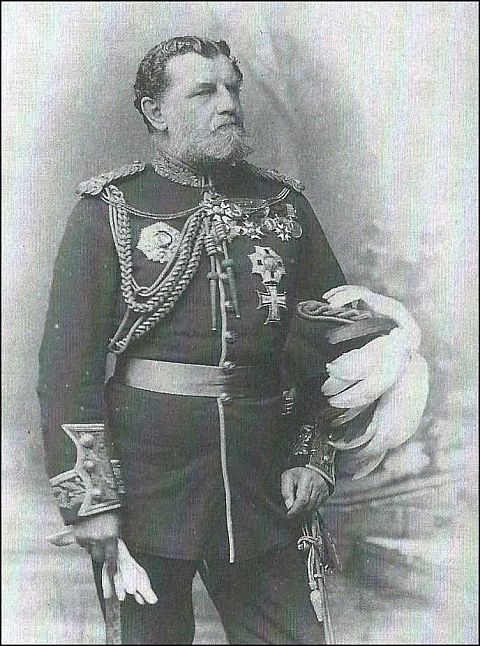
Major-General C.C. Teesdale,
V.C., K.C.M.G.
Appointed Master of the Ceremonies in Ordinary to Her Majesty Queen Victoria on 1st June 1890.
He also received the following foreign honours:
He was a talented water colour artist and the illustrations which appeared in the book "a narrative of the siege of Kars", published in 1856, were possibly done whilst he was in captivity.
He came from a remarkable military family whose members were at Culloden, Belle Isle, Martinique, the Gordon Riots, possibly Waterloo, Cape St Vincent, Ceylon and many other situations.
Christopher Teesdale never married. He retired from the army on 22 March 1892, and died at home in South Berstred, Sussex, on 1st December 1893.
One final statistic regarding the VictoriaCross awarded for Crimea. The eleven V.C's awarded for Rorke's Drift are well known, but what is not known, is that an even greater number of 18 Victoria Crosses were awarded for gallantry on a single day on 5 November 1854 at the battle of Inkerman, 14 to the army and 4 to the navy.
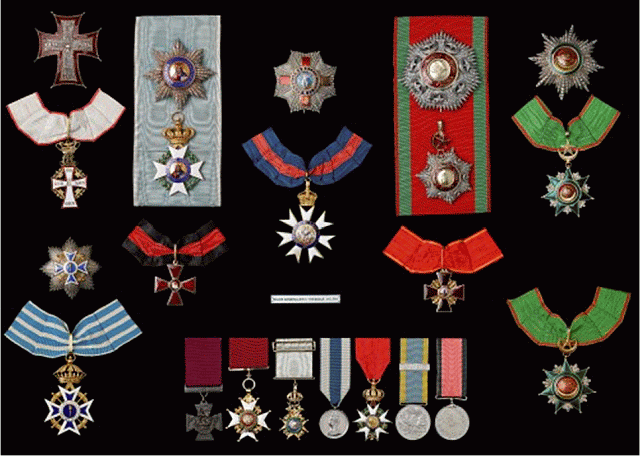
The colour photo of his medals which was
on the inside front cover of this issue,
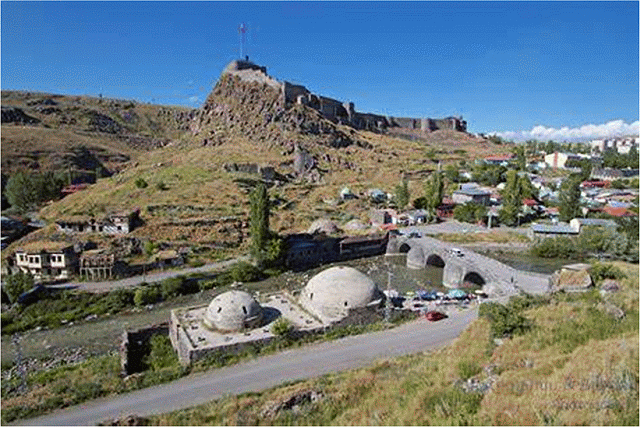
The citadel still towers over modern day Kars in Turkey
About the Author
Brian Thomas is a retired chartered accountant. He attended the second lecture of the S.A.M.H.S., given by Lt-Col B. Simpkins M.M., whilst on business in Johannesburg in 1967. He relocated to Johannesburg within 6 months and was the honorary auditor of the Society for the following four years before moving to Durban.
He has been a medal collector of note for over 50 years and built up a major collection which he has now sold. Apart from family groups he retained only the group to Garnet Green M.C. and bar. Green's story was published in Military History Journal Vol 19 no 3, Dec 2021.
He now spends time writing the stories of the recipients of his former medal groups for the SAMHS, the Orders and Medals Society of Britain and the magazine Medal News.
His wife of over 60 years, Barbara, is very supportive of his hobby.
Return to Journal Index OR Society's Home page
South African Military History Society / scribe@samilitaryhistory.org